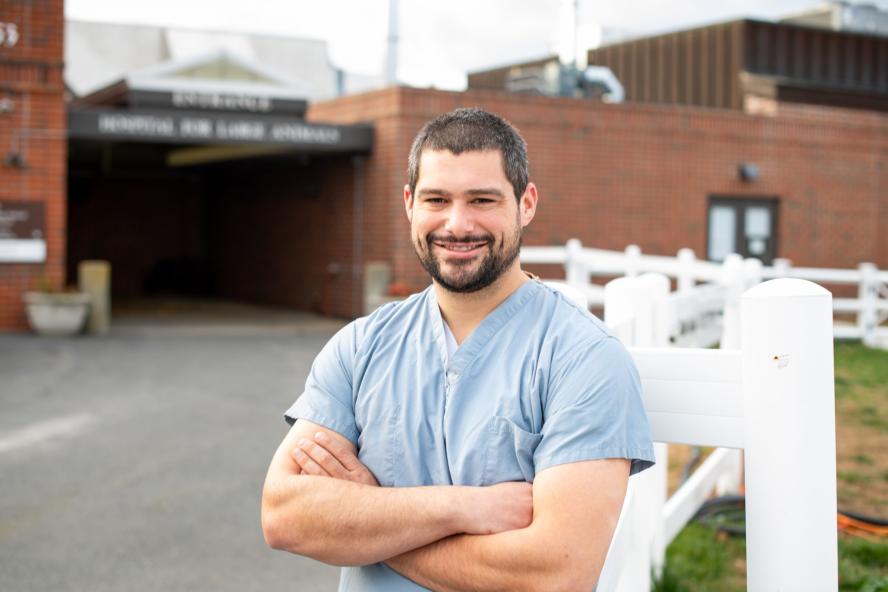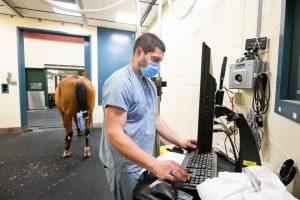-
About
- Leadership & Faculty
- News & Events
-
Academics
- Graduate
- Advanced Clinical Training
- Continuing Education
-
Student Life
-
Research
-
Hospitals & Clinics
- Emergency Care
- Hospital Services
-
Community Outreach
- Volunteer
Seeing Further
As a veterinary technician working in nuclear medicine and CT, Josh Peters has the unique capability to help reveal health issues in animals of all sizes

You could say that Josh Peters is a bit of a detective. As a veterinary technician dedicated to diagnostic imaging, Peters helps pinpoint areas of issue for patients that are otherwise not readily apparent.
“It’s almost like solving a puzzle,” says Peters, who works with both large and small animals, from hedgehogs and ferrets to horses, giraffes, and tapirs—and everything in between. “I really enjoy being a part of the process of fixing things, especially when it’s an emergency case where the imaging turns out to play a really crucial role.”
“We cannot run the CT suite without Josh,” says Mauricio Solano, head of the diagnostic imaging service. “Over the years, has managed to become indispensable in several areas of our section.”
Peters started off working with pets at the Henry & Lois Foster Hospital for Small Animals, before getting a foot in the door with the Hospital for Large Animals. His position continued to evolve until he found his niche—working in nuclear medicine (also known as bone scans) and computed tomography (or CT scans) with animals of all species and sizes.
“He started as a small-animal technician, and, due to his curious mind, cross-trained as a large-animal radiology tech as well. From there, he became proficient in nuclear medicine, dealing with our sports medicine equine service,” says Solano. “True to his spirit, he had the organizational skills to set aside time during his busy day to learn the ins and outs of CT. And when the main CT person retired, he was the perfect fit to lead the CT imaging suite.”
One of the most important aspects of Peters’ job is getting good, clear images. The key? A lot of patience, Peters says. “When you’re doing a bone scan on a horse, you’re working with a big, easily frightened animals—and they have to stand perfectly still for 30 seconds to a minute for each image while you move this big camera around them.”
Diagnostic imaging also takes a lot of knowledge and experience, including using the best exposure techniques, the proper amount of sedation, good animal handling skills, and excellent communication skills, oftentimes utilizing a team of people.
Peters “is always an advocate for the wellbeing of our patients,” says Solano. “He has a good eye to read our patients. He can see their subtle mannerisms and foresee if a patient will be an easy one to deal with or one that requires more care.”
A Natural Teacher
In addition to taking great images, Peters plays a crucial role in training the next generation of veterinarians at Cummings School.
“Josh has enormous patience, which is so critical when teaching students,” says Cheryl Blaze, hospital director of the Foster Hospital. She says that she hears from students all the time that “he is encouraging and makes them feel confident.”
Prior to the COVID-19 pandemic, Peters was teaching a small-animal lab, in which veterinary students learned about the safety of the machines, how to run the X-ray equipment and positioning of the animals. On the large-animal side, Peters leads a weeklong elective radiology lab for students with an interest in horses.
The teaching component of his role is particularly meaningful to Peters “because when these students are veterinarians, they are the ones that are going to be making the calls on what diagnostic tests to order, so they need to know what the equipment does and how to use it.”
Solano says Peters’ teaching commitment extends beyond the veterinary students. After once being taught by more senior technicians, now “he is training his fellow techs in CT.”
A Lifelong Learner
Peters always knew he wanted to work with animals, particularly horses. He grew up next to a farm in Walpole, Massachusetts, and rode Western throughout childhood and early adulthood. He attended Norfolk County Agricultural High School, followed by Johnson and Wales University, where he majored in equine business management.
At Johnson and Wales, Peters became enamored with dressage. He landed a position managing a big dressage barn after graduation, but he soon realized his favorite part was the upkeep of the horse—and decided that a profession in veterinary care was right for him.
After spending time as a veterinary technician caring for sport horses in private practice, Peters took a position in diagnostic imaging at Tufts, where he was always interested in working. “I liked that it was a large facility that had a lot of interesting cases come through,” he says.
Since arriving at Cummings School, Peters has completed an associate’s degree program in veterinary technology at Penn Foster College and also became a certified veterinarian technician—all while working full-time.
“It was definitely a lot, but it was something I wanted to do,” he says. “I like to learn as much as I can, and I really love diagnostic imaging. I definitely see myself doing it for life.”
